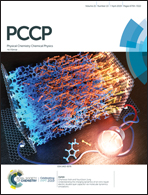Quantum state-to-state study for (H−(D−),HD) collisions on two potential energy surfaces†
Abstract
Quantum time-dependent wave-packet calculations have been carried out to explore the state-to-state dynamics of the ion–molecule (H−(D−),HD) collisions on two accurate ab initio potential energy surfaces in the collision energy range 0.2–1.2 eV. Total and final state-resolved integral and differential cross sections are elaborated in detail. The differential cross sections vary substantially with the collision energy, turning from predominantly backward-scattering at low collision energies to forward and sideways scattering bias at relatively high collision energies. The rebound, stripping and time-delayed mechanisms are found to be possible in (H−(D−),HD) collisions. A set of quasi-classical trajectory calculations were performed, and the results indicate that the backward-scattering peak is caused by the low impact parameter trajectories, while the trajectories of high impact parameter are responsible for the forward scattering. A set of representative state-to-state differential cross sections at collision energies 0.6 and 1.2 eV are also presented. Different reaction mechanisms are dominant in (H−(D−),HD) collisions at different collision energies, resulting in different product rovibrational state distributions. The differences between the dynamics results based on the two potential energy surfaces are also discussed.



 Please wait while we load your content...
Please wait while we load your content...